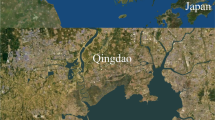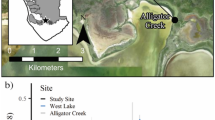Abstract
Understanding the relationships between hydrology and salinity and plant community structure and production is critical to allow predictions of wetland responses to altered water management, changing precipitation patterns and rising sea-level. We addressed how salinity, water depth, hydroperiod, canal inflows, and local precipitation control marsh macrophyte aboveground net primary production (ANPP) and structure in the coastal ecotone of the southern Everglades. We contrasted responses in two watersheds - Taylor Slough (TS) and C-111 - systems that have and will continue to experience changes in water management. Based on long-term trajectories in plant responses, we found continued evidence of increasing water levels and length of inundation in the C-111 watershed south of the C-111 canal. We also found strong differentiation among sites in upper TS that was dependent on hydrology. Finally, salinity, local precipitation and freshwater discharge from upstream explained over 80 % of the variance in Cladium ANPP at a brackish water site in TS. Moreover, our study showed that, while highly managed, the TS and C-111 watersheds maintain legacies in spatial pattern that would facilitate hydrologic restoration. Based on the trajectories in Cladium and Eleocharis, shifts in plant community structure could occur within 5–10 years of sustained water management change.






Similar content being viewed by others
References
Barr JG, Engel VC, Fuentes JD, Zieman JC, O’Halloran TL, Smith TJ III, Anderson GH (2010) Controls on mangrove forest-atmosphere carbon dioxide exchanges in western Everglades National Park. Journal of Geophysical Research Biogeosciences 115:G02020. doi:10.1029/2009JG001186
Busch J, Mendelssohn IA, Lorenzen B, Brix H, Miao S (2004) Growth responses of the Everglades wet prairie species Eleocharis cellulose and Rhynchospora tracyi to water level and phosphate availability. Aquatic Botany 78:37–54
Chen H, Mendelssohn IA, Lorenzen B, Brix H, Miao S (2005) Growth and nutrient responses of Eleocharis cellulose (Cyperaceae) to phosphate level and redox intensity. American Journal of Botany 92:1457–1466
Childers DL, Doren RF, Noe GB, Rugge M, Scinto LJ (2003) Decadal change in vegetation and soil phosphorus patterns across the Everglades landscape. Journal of Environmental Quality 32:344–362
Childers DL, Iwaniec D, Rondeau D, Rubio G, Verdon E, Madden CJ (2006a) Responses of sawgrass and spikerush to variation in hydrologic drivers and salinity in Southern Everglades marshes. Hydrobiologia 569:273–292
Childers DL, Boyer JN, Davis SE, Madden CJ, Rudnick DT, Sklar FH (2006b) Relating precipitation and water management to nutrient concentrations in the oligotrophic “upside-down” estuaries of the Florida Everglades. Limnology and Oceanography 51:602–616
Daoust RJ, Childers DL (1998) Quantifying aboveground biomass and estimating productivity in nine Everglades wetland macrophytes using a non-destructive allometric approach. Aquatic Botany 62:115–133
Daoust RJ, Childers DL (2004) Ecological effects of low-level phosphorus additions on two plant communities in a neotropical freshwater wetland ecosystem. Oecologia 141(4):672–686
Davis SM, Ogden JC (1994) Everglades, the ecosystem and its restoration. St. Lucie Press, Florida
Edwards AL, Lee DW, Richards JH (2003) Responses to a fluctuating environment: effects of water depth on growth and biomass allocation in Eleocharis cellulosa Torr. (Cyperaceae). Canadian Journal of Botany 81:964–975
Florida Oceans and Coastal Council (FOCC) (2010) Climate change and sea-level rise in Florida: an update of the “The effects of climate change on Florida’s ocean and coastal resources.” [2009 report] Tallahassee, Florida, 26p
Howard RJ, Mendelsshohn IA (1999) Salinity as a constraint on growth of oligohaline marsh macrophytes. I. Species variation in stress tolerance. American Journal of Botany 86:785–794
Macek P, Rejmankova E (2007) Response of emergent macrophytes to experimental nutrient and salinity additions. Functional Ecology 21:478–488
Merino JH, Huval D, Nyman AJ (2010) Implication of nutrient and salinity interaction on the productivity of Spartina patens. Wetlands Ecology and Management 18:111–117
Miao SL, Zou CB (2012) Effects of inundation on growth and nutrient allocation of six macrophytes in the Florida Everglades. Ecological Engineering 42:10–18
Noe G, Childers DL, Jones RD (2001) Phosphorus biogeochemistry and the impacts of phosphorus enrichment: why are the Everglades so unique? Ecosystems 4:603–624
Parker III FM (2000) Changes in water inputs and nutrient loading after restoration of water flow to a Southern Ever- glades wetland landscape. MS Thesis, Florida International University, Miami, FL, 128 pp
Pearlstine LG, Pearlstine EV, Aumen NG (2010) A review of the ecological consequences and management implications of climate change for the Everglades. Journal of the North American Benthological Society 29:1510–1526
Rejmankova E, Macek P (2008) Response of root and sediment phosphatase activity to increased nutrients and salinity. Biogeochemistry 90:159–169
Ross MS, Meeder JF, Sah JP, Ruiz PL, Telesnicki GJ (2000) The southeast saline Everglades revisited: 50 years of coastal vegetation change. J. Vegetation Science 11:101–112
Rudnick DT, Chen Z, Childers DL, Boyer JN, Fontaine TD III (1999) Phosphorus and nitrogen inputs to Florida Bay: the importance of the Everglades watershed. Estuaries 22:398–416
Surratt D, Shinde D, Aumen N (2012) Recent cattail expansion and possible relationships to water management: changes in Upper Taylor Slough (Everglades National Park, Florida, USA). Environmental Management 49:720–733
Todd MJ, Muneepeerakul R, Miralles-Wilhelm F, Rinaldo A, Rodriguez-Iturbe I (2012) Possible climate change impacts on the hydrological and vegetative character of Everglades National Park, Florida. Ecohydrology 5:326–336
Troxler TG (2012) Ecological monitoring of southern Everglades wetlands, mangrove transition zone and “white zone” interactions with Florida Bay. Annual Report to the South Florida Water Management District, West Palm Beach, Fl. 65p
United States Army Corps of Engineers (USACE) (2011) Central and Southern Florida project, C-111 spreader canal western project: final project implementation report and environmental impact statement. http://www.evergladesplan.org/pm/projects/docs_29_c111_pir.aspx
Wetzel PR (2001) Plant community parameter estimates and documentation for the Across Trophic Level System Simulation (ATLSS). Institute for Environmental Modeling, University of Tennessee-Knoxville, TN
Zhang K, Dittmar J, Ross M, Bergh C (2011) Assessment of sea level rise impacts on human population and real property in the Florida Keys. Climate Change 107:129–146
Acknowledgments
This work would not have been possible without the herculean field efforts by Damon Rondeau, Greg Losada, Gustavo Rubio, Tim Grahl, Emilie Grahl, Adam Hines and Olga Sanchez. This work was funded by the South Florida Water Management District and Everglades National Park. ENP water level data were made available by ENP (South Florida Natural Resources Center (SFNRC) DataForEVER Dataset, Everglades National Park, Homestead, FL, Generated by D. Rondeau using Appaserver software (http://www.appaserver.com), Sacramento, CA, Public URL not currently available, please send data requests to EVER_data_request@nps.gov). We would like to further acknowledge the field assistance of numerous Florida Coastal Everglades LTER collaborators. This is SERC contribution # 625.
Author information
Authors and Affiliations
Corresponding author
Rights and permissions
About this article
Cite this article
Troxler, T.G., Childers, D.L. & Madden, C.J. Drivers of Decadal-Scale Change in Southern Everglades Wetland Macrophyte Communities of the Coastal Ecotone. Wetlands 34 (Suppl 1), 81–90 (2014). https://doi.org/10.1007/s13157-013-0446-5
Received:
Accepted:
Published:
Issue Date:
DOI: https://doi.org/10.1007/s13157-013-0446-5




